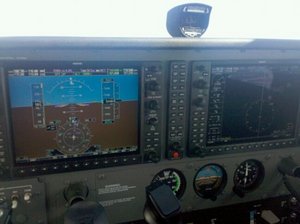Flying at the correct altitude can mean the difference between life and death when it comes to aviation safety. A majority of mid-air collisions and near mid-air collisions occurs when pilots are flying at the wrong altitude. When you are determining what altitude to fly at, you need to know whether you are on an IFR or VFR flight plan and the direction you are flying. To improve flight efficiency, you will also want to know the winds aloft along your route of flight.
Step 1- Determine what altitude you should fly at, based on your flight plan and magnetic course:
To determine what altitude you should fly at, you need to know what type of flight you are conducting and your magnetic course. If you are flying on a VFR flight plan, you should fly at an even or odd thousand MSL (Mean Sea Level) plus 500 feet. If you are flying a magnetic course of 0 degrees through 179 degrees, you should fly at any odd thousand foot MSL altitude plus 500 feet (i.e. 3,500, 5,500, 7,500 and so on). If you are flying a magnetic course of 180 degrees through 359 degrees, you should fly at any even thousand foot MSL altitude plus 500 feet (i.e. 4,500, 6,500, 8,500, and so on).
Determining what altitude to fly at for an IFR flight plan is similar to determining the altitude for VFR. The biggest difference is that you should file to fly at either an even or odd thousand MSL. If you are flying a magnetic course of 0 degrees through 179 degrees, you should fly at any odd thousand foot MSL altitude (i.e. 3,000, 5,000, 7,000, and so on). If you are flying a magnetic course of 180 degrees through 359 degrees, you should fly at any even thousand foot MSL altitude (i.e. 4,000, 6,000, 8,000). If One of the differences is that in mountainous areas you must fly at least 2,000 feet above the highest obstacle within a horizontal distance of 4 nautical miles from your course or 1,000 feet above the highest obstacle within a horizontal distance of 4 nautical miles from your course.
Step 2- Determine the most efficient altitude to fly at:
Efficiency should always be on your mind when determining the altitude you want to fly at. For the best efficiency you should try to fly at an altitude that has the smallest amount of headwind or the largest amount of tailwind. To find out what altitudes have the most favorable winds, you will have to look at the winds aloft. While looking at the winds aloft, note altitudes that have a high headwind and try to avoid those altitudes. You will also want to note the altitudes that have the highest tailwinds and try to fly at those altitudes. Unfortunately, you will not always have favorable winds and you might have to fly into a strong headwind. If you are lucky, you can fly at an altitude that has a relatively strong tailwind.
Using the winds in your favor can save you time and money. If you get a strong tailwind, you can travel the same distance in a shorter amount of time and a lower amount of fuel consumption. If you are travelling 100NM at 100KIAS with a 10 knot tailwind, your groundspeed will be 110 knots and you will reach your destination in approximately 55 minutes. However, if you are travelling against a 10 knot headwind, your groundspeed will be 90 knots and you will reach your destination in approximately 65 minutes. That 10 minutes difference could save you a few gallons of gas depending on your fuel consumption.
After you determine which altitudes have the most favorable winds, you will then need to make a judgment how efficient it would be to get to that altitude. For example, if you are flying a Cessna 172 on a 80NM trip and the highest tailwinds are at 8,000 feet MSL. It most likely would not be efficient to climb to 8,000 feet because by the time you got to that altitude you would have to descend almost immediately and you would more likely burn more gas than if you climbed to a lower altitude. You will want to climb to a lower cruising altitude, most likely either 4,000 ft. or 6,000 ft. If the trip is longer, maybe 250 or 300NM, it would most likely be more efficient to climb to that higher altitude. You will be able to fly with the stronger tailwind for a long distance of time, saving you money, gas, and time. You can look at the altitudes on the winds aloft and determine which altitude has the most favorable wind.
Determining what altitude to fly at is a very important part of flight planning. With careful planning, this step can prevent mid-air collisions and make your flight more efficient. Using the winds aloft, you can determine and judge what altitudes would be the most efficient for your flight.



